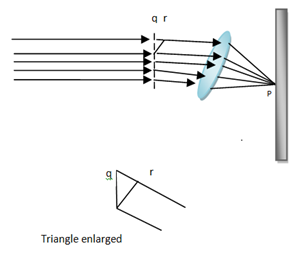Question 7: What is diffraction grating? How can the wave length of a beam of light be measured with it?
ANSWER
Based on the principles of diffraction and interference of light, the grating is a glass or plastic plate upon which is scratched a large number of parallel lines, usually of the order of 7500/cm. The space between each scratch line is transparent and allows light to pass through. In this way, the transparent spaces between the scratched lines act as separate slits. Light waves after diffraction through the grating interfere with one another. Grating is used to find the unknown wavelength of light.

Consider the diagram. A parallel beam of light through the collimator falls on the grating. It sends out waves from each slit. The parallel rays after diffraction through the grating are making an angle θ with normal at the point of incidence. These lines are then focused on a point ‘p’ of the screen by an achromatic lens. An interference pattern is observed. If the path difference between two rays 1 and 2 is λ, constructive interference is observed at point P of the screen by an achromatic lens. An interference pattern is observed. If the path difference between two rays 1 and 2 is λ constructive interference takes place at P. Similarly, waves from any two consecutive slits would have path difference λ at p and a bright fringe will be seen here. Hence, the condition for constructive interference is that,
Path difference = λ
But path difference = rq (see the diagram), therefore,
rq = λ ⇒ rq = d sinθ
Where d is the separation between the two slits, called grating element. Value of the grating element can be calculated by total number of lines in unit length.
Thus d = 1 (cm)/N (N is the number of lines in 1 cm)
Needs not to say there would be other points above and below O where the condition for constructive interference will meet,
d sinθ = 2λ, 3λ, 4λ … = mλ
Where m = 1, 2, 3…
This is the general form of grating equation. Wavelength λ can be calculated by λ = d sinθ/m

Pingback:michelsons-interferometer – msa
Pingback:interference-and-its-conditions – msa
Pingback:Comprehensive Questions, Physical Optics … msa – msa
Pingback:Physical Optics, Comprehensive Questions … msa – msa
Pingback:index-cq-ch9-p11